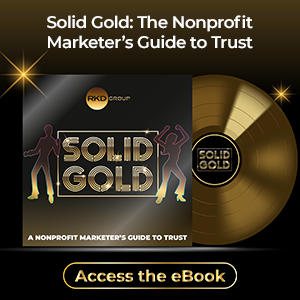We have found ourselves in a giving paradox: Americans are still generous, but most organizations’ files show fewer donors giving more. Headlines based on select research say giving is on the decline, but I believe the reality is more nuanced. So, if generosity isn’t dying, how is it evolving?
Reviewing several longitudinal research studies, such as RKD’s Giving Barometer and those by the Lilly Family School of Philanthropy, we can tease out the trends in individual giving. Recognizing current trends allows for relevancy in responding to the current moment.
Economic outlook
The current economic climate is marked with unevenness and strong emotions. Both the University of Michigan Consumer Sentiment Index and RKD’s Q4 Giving Barometer, fielded at the start of the government shutdown, show heightened uncertainty among consumers.

- Need for support is growing, and thankfully for nonprofits feeling the pinch between rising demand and declining funding due to federal grant-funding cuts, donors see that. This needn’t be a political statement that causes more division: 89% of all charitable donors believe there is more need for donations as a result. While there are differences in amount of perceived need by political leaning, donors are united on that need.
- Inflation pressures are easing. 42% of donors say inflation affected their giving in the past 12 months, down 16 points year over year.
- Consumer sentiment is low—and down for all consumers except for those with large stock holdings. This is a reflection of the two-speed, or bifurcated, economy. The growing wealth gap creates two groups with very different experiences: those stagnating or declining and those growing.
- Recession expectations remain high. 61% of donors think a recession is likely, reflecting widespread anxiety about economic stability.
What does this mean for fundraisers? With the stock market at an all-time high, there are natural opportunities to lean into giving through donor-advised funds (DAFs), relational, and stock-based giving while continuing to nurture sustaining monthly and mid-level giving programs for stability and long-term growth.
“Giving is down” isn’t the whole story
The data behind the decline in individual giving can paint an incomplete picture. The detail of a study’s methodology is often buried or overlooked, leading to headlines with incomplete conclusions.
1. Religious giving is driving much of the drop
A large portion of the decline in charitable giving stems from fewer people attending and giving to religious institutions. This detail is typically overlooked in charitable giving studies.
Source: IU Lilly Family School of Family Philanthropy’s Philanthropy Panel Study from The Giving Environment report, July 2021. Note that the updated 2024 report analyzes a different subset of households and is not included.
2. Giving to charitable organizations is consistent
When the charitable giving definition excludes giving to churches, houses of worship and political campaigns, and includes all giving amounts, we see a more consistent picture of charitable giving over time. Including all giving amounts is a better reflection of generosity in general as supporters who perhaps can only afford micro-giving (rounding up at the point of sale, for example) still have a generous nature that is reflected in volunteering, social advocacy and other forms of generosity that make a sizeable impact.
Source: Giving Sciences and RKD tracking studies.
3. Growth in community-driven giving models
Giving circles—groups of individuals who pool their money and collectively decide which organizations and causes to fund—have experienced rapid growth. Their combination of social connection and shared purpose is drawing in new supporters, ultimately expanding reach and impact for the causes they choose.
Another more personal method of giving that continues to grow is crowdfunding, which primarily benefits individuals or families. According to 2025 research from Giving Sciences, a quarter (25%) of donors have given via GoFundMe in the past year, with the majority (82%) saying their giving benefited individuals or families versus charities. This is notable in that it falls outside of IRS-tracked charitable data, which tracks giving to registered 501(c)(3) organizations. This means that our trusted sources of overall giving, such as Giving USA, can’t show the full picture of charitable giving.
Then why are fewer donors giving more on (almost) all files?
So, if generosity is alive and well in the U.S., why are we consistently seeing fewer donors giving more for most charitable organizations?
- Affluent households represent a larger share of giving. The stock market surge since the pandemic has benefited those with appreciated assets. “Feeling a personal responsibility to give or tithe” is now the top giving motivator, after a decade of being runner up. This motivation has increased since the pandemic, alongside the growth in housing valuation and the stock market. It’s up the most among older and wealthier donors.
- There’s greater competition for dollars. According to a report by Philanthropy Roundtable, between 2000 and 2023, the number of 501(c)(3) nonprofits increased by 85%. Despite growing opportunities to give to more organizations as well as crowdfunding sites, Giving Sciences and RKD tracking studies show the median number of charities supported per donor remains three and grows to five for the top-earning households of $250K+.
- Generosity is bigger than dollars alone. About a quarter (24%) of U.S. adults volunteer, with participation rising alongside income and declining with age. In addition, newer forms of support, including social advocacy and monetization (engaging with social content to benefit the creator or brand), account for about 12% of preferred giving methods, with higher rates among younger donors.
Source: RKD Q4 Barometer of 1,205 U.S. adults, October 2025.
What fundraisers can do now
The giving landscape has changed, but the fundamentals still work with some adaptations. Consider the following strategies:
- Align messaging with need, not politics. Across party lines, 89% of donors agree that nonprofits face a greater need for donations due to federal grant cuts. Authentic communications and local media partnerships are key to amplifying that message.
- Lean into relational and transformation giving. Engage high-capacity donors through DAFs, appreciated assets and family foundations.
- Double down on stewardship and trust-building. Larger gifts mean higher expectations for transparency and connection.
- Make monthly giving accessible for all generations. Gen Z and Seniors alike prefer monthly giving for the organizations they support.
- Grow generosity in all of its forms. From volunteering to social advocacy, expanding the supporter definition provides a current benefit as well as paves the way for these supporters to become future financial donors.
As the fundraising environment continues to evolve, one truth remains: Individual generosity endures, though it takes new forms that don’t always get measured. Fundraisers leaning into relationships and trust building with diverse supporters will be best positioned to thrive in the next era of philanthropy.


.png?width=2000&height=2000&name=image%20(30).png)



Leave a comment: